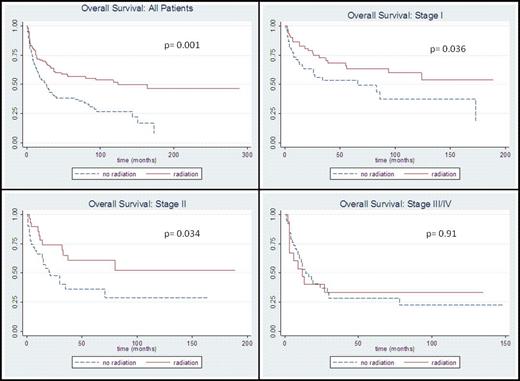Abstract
The role of radiation therapy in peripheral T-cell lymphoma (PTCL) is not well established. While the NCCN guidelines recommend combined modality treatment with consolidative radiation therapy after chemotherapy for localized (stage I and II) disease, the data supporting this recommendation is lacking and is extrapolated from B-cell lymphoma.
This is a retrospective analysis of outcome in patients with non-cutaneous peripheral T-cell lymphoma of the head and neck from the Surveillance, Epidemiology and End Results (SEER) database diagnosed between 1981-2010. Survival was estimated by Kaplan-Meier estimates using the log-rank test. Univariate and multivariable analyses were performed using Cox regression analysis.
Of the 307 patients analyzed, 130 (43%) underwent radiation therapy. The median age was 59 years old, 60.3% were male, 73.9% were Caucasian and the median year of diagnosis was 2004. The majority of patients had PTCL, Not Otherwise Specified (74.3%), followed by anaplastic large cell histology (22.2%). Patients were grouped as stage I (47.2%), stage II (29.9%) and stage III/IV (22.8%). Head and neck sites included the nasal cavity (28.3%), oropharynx (25.7%), oral cavity (21.2%), salivary gland (11.7%), nasopharynx (7.8%) and larynx/hypopharynx (5.2%).
The median follow-up was 54 months for survivors. Radiation therapy was associated with a higher 5-year overall survival in all patients (56.7% vs. 38.4%, p=0.001), patients with stage I disease (63.4% vs. 53.4%, p=0.036) and patients with stage II disease (60.8% vs. 36.3%, p=0.034), see Figure 1. Radiation therapy was not associated with a difference in overall survival in patients with stage III/IV disease (p=0.91).
Univariate analysis demonstrated that age, stage, radiation therapy and marital status were predictive of overall survival, but sex, and race were not. The year (p=0.93) or decade of treatment (p=0.67) did not impact overall survival. On multivariable analysis, increasing age (HR: 1.02, p<0.001), increasing stage (HR: 1.42, p=0.004), radiation therapy (HR: 0.60, p=0.011) and marital status of not married (HR: 1.49, p=0.035) remained statistically significant predictors of overall survival.
An additional analysis was performed excluding patients who survived less than 3 months to account for mortality related to disease progression or chemotherapy toxicity. After excluding these 45 patients, radiation therapy was still associated with increased overall survival in all patients (p<0.001) and in patient with limited stage disease (p=0.021).
The integration of local radiation therapy to the treatment of PTCL of the head and neck may improve overall survival in patients with limited stage disease.
No relevant conflicts of interest to declare.
Author notes
Asterisk with author names denotes non-ASH members.


This feature is available to Subscribers Only
Sign In or Create an Account Close Modal